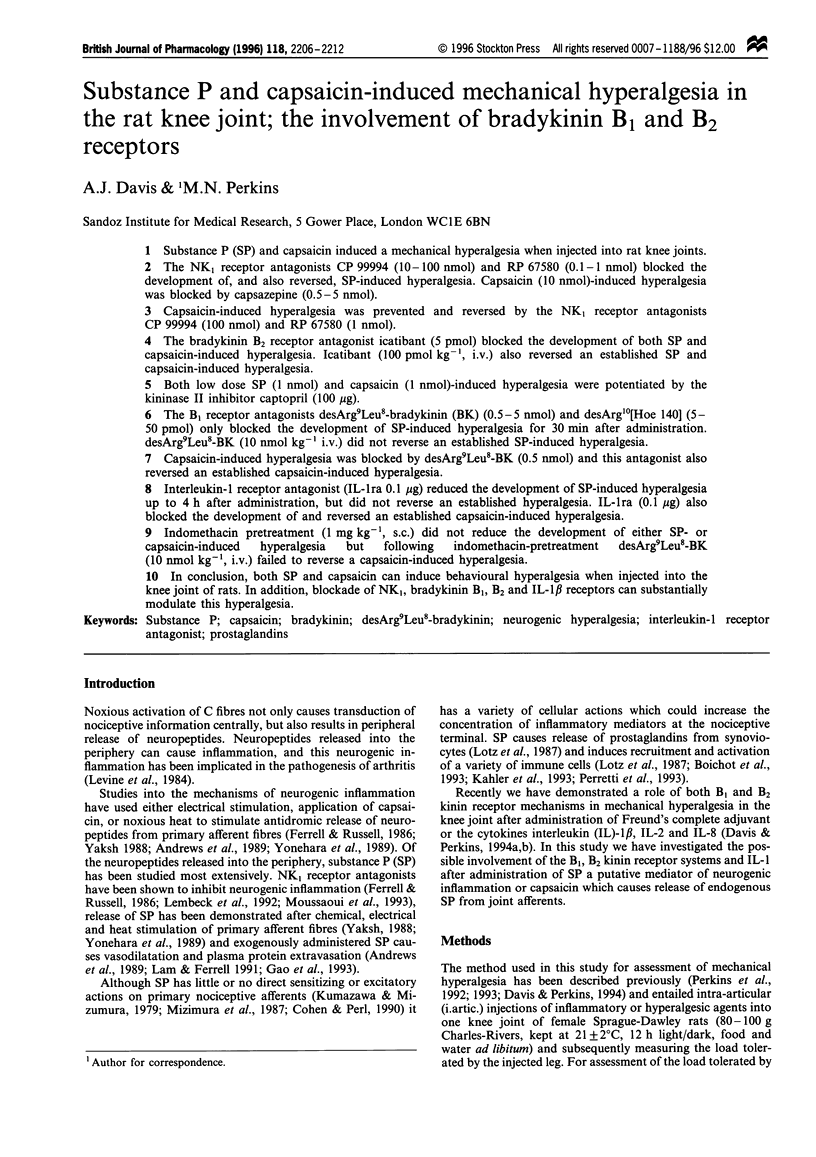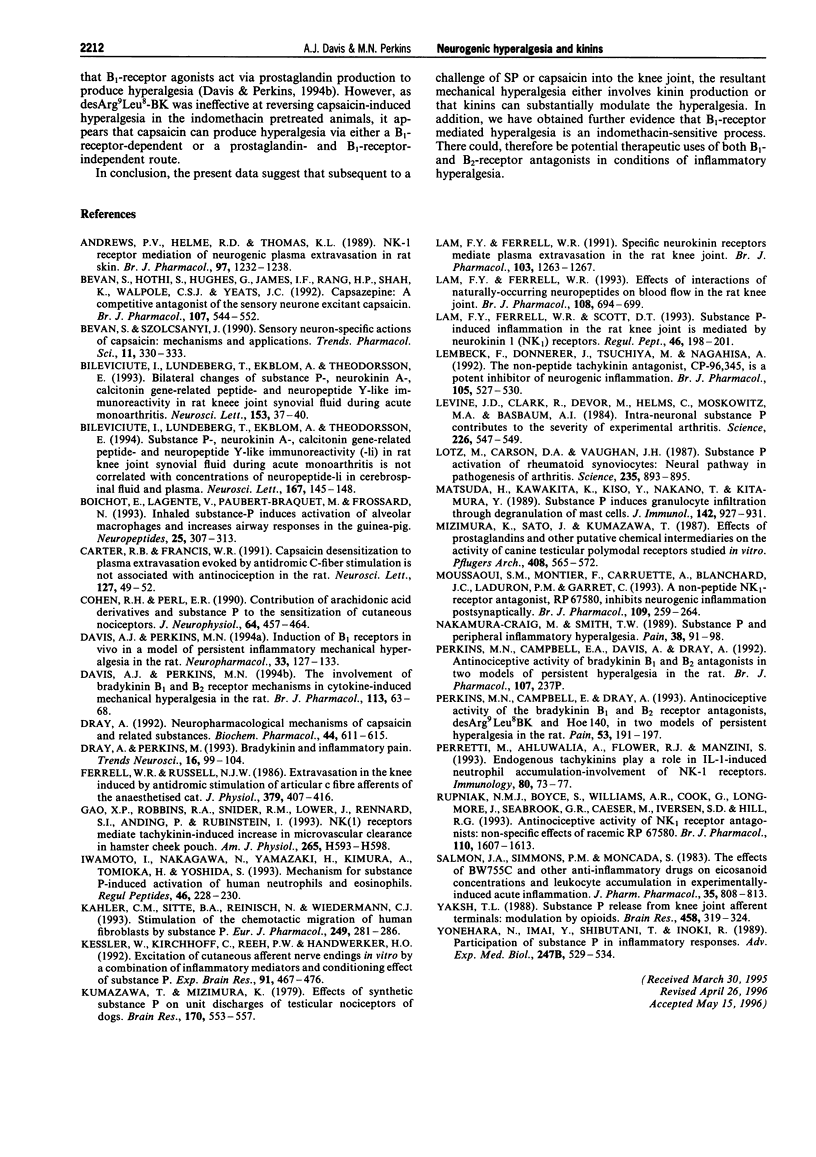Abstract
1. Substance P (SP) and capsaicin induced a mechanical hyperalgesia when injected into rat knee joints. 2. The NK1 receptor antagonists CP 99994 (10-100 nmol) and RP 67580 (0.1-1 nmol) blocked the development of, and also reversed, SP-induced hyperalgesia. Capsaicin (10 nmol)-induced hyperalgesia was blocked by capsazepine (0.5-5 nmol). 3. Capsaicin-induced hyperalgesia was prevented and reversed by the NK1 receptor antagonists CP 99994 (100 nmol) and RP 67580 (1 nmol). 4. The bradykinin B2 receptor antagonist icatibant (5 pmol) blocked the development of both SP and capsaicin-induced hyperalgesia. Icatibant (100 pmol kg-1, i.v.) also reversed an established SP and capsaicin-induced hyperalgesia. 5. Both low dose SP (1 nmol) and capsaicin (1 nmol)-induced hyperalgesia were potentiated by the kininase II inhibitor captopril (100 micrograms). 6. The B1 receptor antagonists desArg9Leu8-bradykinin (BK) (0.5-5 nmol) and desArg10[Hoe 140] (5-50 pmol) only blocked the development of SP-induced hyperalgesia for 30 min after administration. desArg9Leu8-BK (10 nmol kg-1 i.v.) did not reverse an established SP-induced hyperalgesia. 7. Capsaicin-induced hyperalgesia was blocked by desArg9Leu8-BK (0.5 nmol) and this antagonist also reversed an established capsaicin-induced hyperalgesia. 8. Interleukin-1 receptor antagonist (IL-1ra 0.1 microgram) reduced the development of SP-induced hyperalgesia up to 4 h after administration, but did not reverse an established hyperalgesia. IL-1ra (0.1 microgram) also blocked the development of and reversed an established capsaicin-induced hyperalgesia. 9. Indomethacin pretreatment (1 mg kg-1, s.c.) did not reduce the development of either SP- or capsaicin-induced hyperalgesia but following indomethacin-pretreatment desArg9Leu8-BK (10 nmol kg-1, i.v.) failed to reverse a capsaicin-induced hyperalgesia. 10. In conclusion, both SP and capsaicin can induce behavioural hyperalgesia when injected into the knee joint of rats. In addition, blockade of NK1, bradykinin B1, B2 and IL-1 beta receptors can substantially modulate this hyperalgesia.
Full text
PDF






Selected References
These references are in PubMed. This may not be the complete list of references from this article.
- Andrews P. V., Helme R. D., Thomas K. L. NK-1 receptor mediation of neurogenic plasma extravasation in rat skin. Br J Pharmacol. 1989 Aug;97(4):1232–1238. doi: 10.1111/j.1476-5381.1989.tb12583.x. [DOI] [PMC free article] [PubMed] [Google Scholar]
- Bevan S., Hothi S., Hughes G., James I. F., Rang H. P., Shah K., Walpole C. S., Yeats J. C. Capsazepine: a competitive antagonist of the sensory neurone excitant capsaicin. Br J Pharmacol. 1992 Oct;107(2):544–552. doi: 10.1111/j.1476-5381.1992.tb12781.x. [DOI] [PMC free article] [PubMed] [Google Scholar]
- Bevan S., Szolcsányi J. Sensory neuron-specific actions of capsaicin: mechanisms and applications. Trends Pharmacol Sci. 1990 Aug;11(8):330–333. doi: 10.1016/0165-6147(90)90237-3. [DOI] [PubMed] [Google Scholar]
- Bileviciute I., Lundeberg T., Ekblom A., Theodorsson E. Bilateral changes of substance P-, neurokinin A-, calcitonin gene-related peptide- and neuropeptide Y-like immunoreactivity in rat knee joint synovial fluid during acute monoarthritis. Neurosci Lett. 1993 Apr 16;153(1):37–40. doi: 10.1016/0304-3940(93)90071-r. [DOI] [PubMed] [Google Scholar]
- Bileviciute I., Lundeberg T., Ekblom A., Theodorsson E. Substance P-, neurokinin A-, calcitonin gene-related peptide- and neuropeptide Y-like immunoreactivity (-LI) in rat knee joint synovial fluid during acute monoarthritis is not correlated with concentrations of neuropeptide-LI in cerebrospinal fluid and plasma. Neurosci Lett. 1994 Feb 14;167(1-2):145–148. doi: 10.1016/0304-3940(94)91048-0. [DOI] [PubMed] [Google Scholar]
- Boichot E., Lagente V., Paubert-Braquet M., Frossard N. Inhaled substance P induces activation of alveolar macrophages and increases airway responses in the guinea-pig. Neuropeptides. 1993 Nov;25(5):307–313. doi: 10.1016/0143-4179(93)90048-f. [DOI] [PubMed] [Google Scholar]
- Cohen R. H., Perl E. R. Contributions of arachidonic acid derivatives and substance P to the sensitization of cutaneous nociceptors. J Neurophysiol. 1990 Aug;64(2):457–464. doi: 10.1152/jn.1990.64.2.457. [DOI] [PubMed] [Google Scholar]
- Dacko S., Schneider J. S. Met-enkephalin immunoreactivity in the basal ganglia in symptomatic and asymptomatic MPTP-exposed monkeys: correlation with degree of parkinsonian symptoms. Neurosci Lett. 1991 Jun 10;127(1):49–52. doi: 10.1016/0304-3940(91)90892-w. [DOI] [PubMed] [Google Scholar]
- Davis A. J., Perkins M. N. Induction of B1 receptors in vivo in a model of persistent inflammatory mechanical hyperalgesia in the rat. Neuropharmacology. 1994 Jan;33(1):127–133. doi: 10.1016/0028-3908(94)90107-4. [DOI] [PubMed] [Google Scholar]
- Davis A. J., Perkins M. N. The involvement of bradykinin B1 and B2 receptor mechanisms in cytokine-induced mechanical hyperalgesia in the rat. Br J Pharmacol. 1994 Sep;113(1):63–68. doi: 10.1111/j.1476-5381.1994.tb16174.x. [DOI] [PMC free article] [PubMed] [Google Scholar]
- Dray A. Neuropharmacological mechanisms of capsaicin and related substances. Biochem Pharmacol. 1992 Aug 18;44(4):611–615. doi: 10.1016/0006-2952(92)90393-w. [DOI] [PubMed] [Google Scholar]
- Dray A., Perkins M. Bradykinin and inflammatory pain. Trends Neurosci. 1993 Mar;16(3):99–104. doi: 10.1016/0166-2236(93)90133-7. [DOI] [PubMed] [Google Scholar]
- Ferrell W. R., Russell N. J. Extravasation in the knee induced by antidromic stimulation of articular C fibre afferents of the anaesthetized cat. J Physiol. 1986 Oct;379:407–416. doi: 10.1113/jphysiol.1986.sp016260. [DOI] [PMC free article] [PubMed] [Google Scholar]
- Gao X. P., Robbins R. A., Snider R. M., Lowe J., 3rd, Rennard S. I., Anding P., Rubinstein I. NK1 receptors mediate tachykinin-induced increase in microvascular clearance in hamster cheek pouch. Am J Physiol. 1993 Aug;265(2 Pt 2):H593–H598. doi: 10.1152/ajpheart.1993.265.2.H593. [DOI] [PubMed] [Google Scholar]
- Iwamoto I., Nakagawa N., Yamazaki H., Kimura A., Tomioka H., Yoshida S. Mechanism for substance P-induced activation of human neutrophils and eosinophils. Regul Pept. 1993 Jul 2;46(1-2):228–230. doi: 10.1016/0167-0115(93)90042-7. [DOI] [PubMed] [Google Scholar]
- Kessler W., Kirchhoff C., Reeh P. W., Handwerker H. O. Excitation of cutaneous afferent nerve endings in vitro by a combination of inflammatory mediators and conditioning effect of substance P. Exp Brain Res. 1992;91(3):467–476. doi: 10.1007/BF00227842. [DOI] [PubMed] [Google Scholar]
- Kumazawa T., Mizumura K. Effects of synthetic substance P on unit-discharges of testicular nociceptors of dogs. Brain Res. 1979 Jul 20;170(3):553–557. doi: 10.1016/0006-8993(79)90974-0. [DOI] [PubMed] [Google Scholar]
- Kähler C. M., Sitte B. A., Reinisch N., Wiedermann C. J. Stimulation of the chemotactic migration of human fibroblasts by substance P. Eur J Pharmacol. 1993 Nov 16;249(3):281–286. doi: 10.1016/0014-2999(93)90523-k. [DOI] [PubMed] [Google Scholar]
- Lam F. Y., Ferrell W. R. Effects of interactions of naturally-occurring neuropeptides on blood flow in the rat knee joint. Br J Pharmacol. 1993 Mar;108(3):694–699. doi: 10.1111/j.1476-5381.1993.tb12863.x. [DOI] [PMC free article] [PubMed] [Google Scholar]
- Lam F. Y., Ferrell W. R., Scott D. T. Substance P-induced inflammation in the rat knee joint is mediated by neurokinin 1 (NK1) receptors. Regul Pept. 1993 Jul 2;46(1-2):198–201. doi: 10.1016/0167-0115(93)90032-4. [DOI] [PubMed] [Google Scholar]
- Lam F. Y., Ferrell W. R. Specific neurokinin receptors mediate plasma extravasation in the rat knee joint. Br J Pharmacol. 1991 May;103(1):1263–1267. doi: 10.1111/j.1476-5381.1991.tb12334.x. [DOI] [PMC free article] [PubMed] [Google Scholar]
- Lembeck F., Donnerer J., Tsuchiya M., Nagahisa A. The non-peptide tachykinin antagonist, CP-96,345, is a potent inhibitor of neurogenic inflammation. Br J Pharmacol. 1992 Mar;105(3):527–530. doi: 10.1111/j.1476-5381.1992.tb09013.x. [DOI] [PMC free article] [PubMed] [Google Scholar]
- Levine J. D., Clark R., Devor M., Helms C., Moskowitz M. A., Basbaum A. I. Intraneuronal substance P contributes to the severity of experimental arthritis. Science. 1984 Nov 2;226(4674):547–549. doi: 10.1126/science.6208609. [DOI] [PubMed] [Google Scholar]
- Lotz M., Carson D. A., Vaughan J. H. Substance P activation of rheumatoid synoviocytes: neural pathway in pathogenesis of arthritis. Science. 1987 Feb 20;235(4791):893–895. doi: 10.1126/science.2433770. [DOI] [PubMed] [Google Scholar]
- Matsuda H., Kawakita K., Kiso Y., Nakano T., Kitamura Y. Substance P induces granulocyte infiltration through degranulation of mast cells. J Immunol. 1989 Feb 1;142(3):927–931. [PubMed] [Google Scholar]
- Mizumura K., Sato J., Kumazawa T. Effects of prostaglandins and other putative chemical intermediaries on the activity of canine testicular polymodal receptors studied in vitro. Pflugers Arch. 1987 May;408(6):565–572. doi: 10.1007/BF00581157. [DOI] [PubMed] [Google Scholar]
- Moussaoui S. M., Montier F., Carruette A., Blanchard J. C., Laduron P. M., Garret C. A non-peptide NK1-receptor antagonist, RP 67580, inhibits neurogenic inflammation postsynaptically. Br J Pharmacol. 1993 May;109(1):259–264. doi: 10.1111/j.1476-5381.1993.tb13562.x. [DOI] [PMC free article] [PubMed] [Google Scholar]
- Nakamura-Craig M., Smith T. W. Substance P and peripheral inflammatory hyperalgesia. Pain. 1989 Jul;38(1):91–98. doi: 10.1016/0304-3959(89)90078-X. [DOI] [PubMed] [Google Scholar]
- Perkins M. N., Campbell E., Dray A. Antinociceptive activity of the bradykinin B1 and B2 receptor antagonists, des-Arg9, [Leu8]-BK and HOE 140, in two models of persistent hyperalgesia in the rat. Pain. 1993 May;53(2):191–197. doi: 10.1016/0304-3959(93)90080-9. [DOI] [PubMed] [Google Scholar]
- Perretti M., Ahluwalia A., Flower R. J., Manzini S. Endogenous tachykinins play a role in IL-1-induced neutrophil accumulation: involvement of NK-1 receptors. Immunology. 1993 Sep;80(1):73–77. [PMC free article] [PubMed] [Google Scholar]
- Rupniak N. M., Boyce S., Williams A. R., Cook G., Longmore J., Seabrook G. R., Caeser M., Iversen S. D., Hill R. G. Antinociceptive activity of NK1 receptor antagonists: non-specific effects of racemic RP67580. Br J Pharmacol. 1993 Dec;110(4):1607–1613. doi: 10.1111/j.1476-5381.1993.tb14008.x. [DOI] [PMC free article] [PubMed] [Google Scholar]
- Salmon J. A., Simmons P. M., Moncada S. The effects of BW755C and other anti-inflammatory drugs on eicosanoid concentrations and leukocyte accumulation in experimentally-induced acute inflammation. J Pharm Pharmacol. 1983 Dec;35(12):808–813. doi: 10.1111/j.2042-7158.1983.tb02901.x. [DOI] [PubMed] [Google Scholar]
- Yaksh T. L. Substance P release from knee joint afferent terminals: modulation by opioids. Brain Res. 1988 Aug 23;458(2):319–324. doi: 10.1016/0006-8993(88)90474-x. [DOI] [PubMed] [Google Scholar]
- Yonehara N., Imai Y., Shibutani T., Inoki R. Participation of substance P in inflammatory responses. Adv Exp Med Biol. 1989;247B:529–534. doi: 10.1007/978-1-4615-9546-5_87. [DOI] [PubMed] [Google Scholar]


